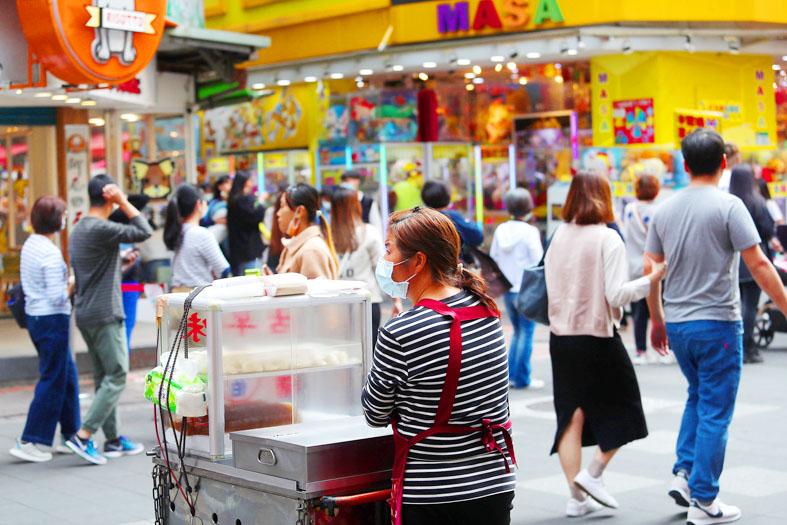The government’s business climate monitor last month was “red” for the first time in a decade, as the economy is heating up due to strong demand for tech and non-tech products, as well as a low comparison base last year.
The monitor gained 3 points to 40, the highest in 32 years. Officials shrugged off bubble and inflation concerns, saying the “red” signal came on the back of solid economic fundamentals.
“Robust exports, private investment and consumer spending accounted for the boom that had nothing to do with bubbles or drastic inflation,” National Development Council (NDC) Deputy Minister Kao Shien-quey (高仙桂) told a media briefing.

Photo: CNA
The council uses a five-color system to portray the nation’s economic state, with “green” indicating steady growth, “red” suggesting overheating and “blue” signaling a recession. Dual colors indicate a transition.
Many have voiced concerns about potential economic bubbles, as COVID-19 infections remain high in many parts of the world, while some research bodies have warned that central banks could reverse loose monetary policies early to rein in inflation risks.
The government has been closely watching international raw material price movements and believes that the price hikes so far are benign, Kao said.
Although Taiwan’s GDP growth this year is forecast to reach 4.64 percent, the central bank last week said it would stand by its current accommodative monetary policy in line with its global peers for fear that a rate hike would attract hot money.
NDC Minister Kung Ming-hsin (龔明鑫) had earlier told lawmakers that the government might consider tightening measures if the boom extends into the second half of this year.
Isolated “red” signals pose no threat, Kung said.
The COVID-19 pandemic started in January last year, weakening economic growth over the following several months, but things started to improve in the second half.
The index of leading indicators, which aims to portray the economic situation for the next six months, picked up 0.52 percent to 106.69, as gauges on imports of semiconductor capital equipment, manufacturing business confidence and labor entry rates all pointed upward, the council said.
However, readings on export orders and new construction floor areas slipped from one month earlier due to unfavorable holiday effects.
The index of coincident indicators, which reflects the current economic state, grew 1.35 percent to 106.8, with markers such as power usage, retail sales, manufacturing sales and restaurant revenue all gaining value due to business improvement, the council said.
Non-farm payrolls and exports declined from a month earlier, as there were fewer working days last month.
Major tech firms are upbeat about their business this month and beyond, lending support to the economic boom.

UNCERTAINTY: Innolux activated a stringent supply chain management mechanism, as it did during the COVID-19 pandemic, to ensure optimal inventory levels for customers Flat-panel display makers AUO Corp (友達) and Innolux Corp (群創) yesterday said that about 12 to 20 percent of their display business is at risk of potential US tariffs and that they would relocate production or shipment destinations to mitigate the levies’ effects. US tariffs would have a direct impact of US$200 million on AUO’s revenue, company chairman Paul Peng (彭雙浪) told reporters on the sidelines of the Touch Taiwan trade show in Taipei yesterday. That would make up about 12 percent of the company’s overall revenue. To cope with the tariff uncertainty, AUO plans to allocate its production to manufacturing facilities in

TAKING STOCK: A Taiwanese cookware firm in Vietnam urged customers to assess inventory or place orders early so shipments can reach the US while tariffs are paused Taiwanese businesses in Vietnam are exploring alternatives after the White House imposed a 46 percent import duty on Vietnamese goods, following US President Donald Trump’s announcement of “reciprocal” tariffs on the US’ trading partners. Lo Shih-liang (羅世良), chairman of Brico Industry Co (裕茂工業), a Taiwanese company that manufactures cast iron cookware and stove components in Vietnam, said that more than 40 percent of his business was tied to the US market, describing the constant US policy shifts as an emotional roller coaster. “I work during the day and stay up all night watching the news. I’ve been following US news until 3am

COLLABORATION: Given Taiwan’s key position in global supply chains, the US firm is discussing strategies with local partners and clients to deal with global uncertainties Advanced Micro Devices Inc (AMD) yesterday said it is meeting with local ecosystem partners, including Taiwan Semiconductor Manufacturing Co (TSMC, 台積電), to discuss strategies, including long-term manufacturing, to navigate uncertainties such as US tariffs, as Taiwan occupies an important position in global supply chains. AMD chief executive officer Lisa Su (蘇姿丰) told reporters that Taiwan is an important part of the chip designer’s ecosystem and she is discussing with partners and customers in Taiwan to forge strong collaborations on different areas during this critical period. AMD has just become the first artificial-intelligence (AI) server chip customer of TSMC to utilize its advanced

Six years ago, LVMH’s billionaire CEO Bernard Arnault and US President Donald Trump cut the blue ribbon on a factory in rural Texas that would make designer handbags for Louis Vuitton, one of the world’s best-known luxury brands. However, since the high-profile opening, the factory has faced a host of problems limiting production, 11 former Louis Vuitton employees said. The site has consistently ranked among the worst-performing for Louis Vuitton globally, “significantly” underperforming other facilities, said three former Louis Vuitton workers and a senior industry source, who cited internal rankings shared with staff. The plant’s problems — which have not